Michelangelo's David and 10 artworks that caused a scandal
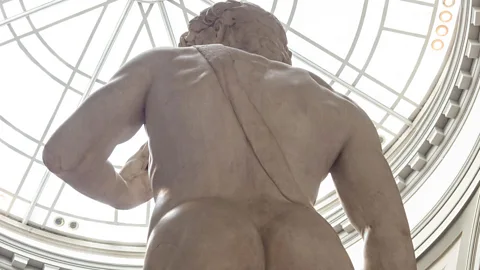 Alamy
AlamyAs a Florida principal was forced to resign after students were shown Michelangelo's statue of David, Kelly Grovier takes a look at the history of censorship in the art world.
When the principal of a charter school in Florida was recently forced to resign after parents alleged that their children had been exposed to pornography when shown photos of the Renaissance master Michelangelo's sculpture of the biblical figure David, many around the world were surprised. That itself is surprising. Almost since the moment that the 17ft (5m)-high nude marble statue was chiselled into scandalous shape in around 1504, Michelangelo's masterpiece has stood its ground against perennial accusations of indecency. The sculpture hadn't even strutted its way through the 16th Century before being fitted with a ludicrous loincloth of metal fig leaves to mitigate its immodesty. It was only in the middle of the 20th Century that similar leaves were finally plucked from the groin of a cast replica of the famous statue on display at the Victoria & Albert Museum in London, which had been given to Queen Victoria in 1857.
The controversial decision taken by the board of Tallahassee Classical School to pressure principal Hope Carrasquilla to quit provides the perfect opportunity to reflect on which works in modern history, while considered by some observers to be unacceptably shocking, have changed the way we think about art. What follows are 10 works created in the years since the fig leaves were removed from the V&A's David that have shocked contemporary sensibilities and helped redefine the very essence of art.
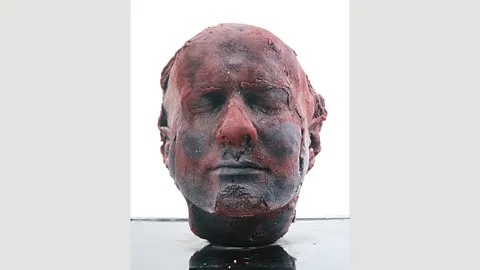 Marc Quinn
Marc Quinn1. Marc Quinn, Self, 1991
Every five years, over the course of five months, British artist Marc Quinn siphons off 5L of his own blood and spills them into a translucent, refrigerated mould of his face. The result is an ever-emerging series of self-portraits into which the artist can legitimately claim to have poured more of himself than any artist that came before him. For some observers, Quinn’s ongoing series Self is nothing more than a gruesome and vampiric stunt. For others, the work embodies a poignant and daring contribution to the tradition of self-representation to which such great artists as Rembrandt, Van Gogh and Cindy Sherman have contributed – one that profoundly highlights the fragility of being.
 Tate
Tate2. Allen Jones, Chair, 1969
Unveiled to accusations that its creator, British Pop artist Allen Jones, treated objects like women and vice versa, Chair (along with companion pieces Hatstand and Table) contorted scantily-clad female mannequins into an un-ergonomically engineered suite of scurrilously lewd furniture. On International Women’s Day in March 1986, the work was doused with paint stripper by a pair of activists appalled by the sculpture’s chauvinist sensibility. The acid ate away at the face and neck, melting the awkward somersault in which the PVC work was forever frozen into a desperate duck-and-roll.
 Tate
Tate3. Piero Manzoni, Merda d’Artista, 1961
If Duchamp’s unused receptacle of human waste could be embraced by the art world as an aesthetic object in its own right, it is perhaps unsurprising that, at some stage, an artist would experiment with excrement itself and attempt to pass it off as a work of art. In 1961, Italian avant-garde artist Piero Manzoni (who, a year earlier, left observers aghast when he presented a balloon filled with his own breath as a work of art), did just that – cramming into 90 tin cans, 2700g of his own faeces. The work is thought to be an elaborate response to a derisory comment that his father, who owned a canning factory, once made to him, likening his work to excrement. In 2016, one of his son’s cans sold at auction for €275,000 (£245,000).
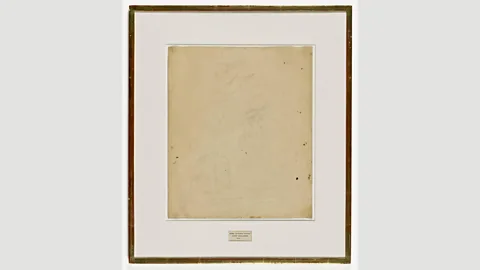 Wikipedia
Wikipedia4. Erased de Kooning Drawing, Robert Rauschenberg, 1953
In 1953, the same year that the curators at the V&A believed modern eyes could handle David's genitals, the US artist Robert Rauschenberg tried his own hand at the art of stripping things away. Curious to know if a work of art could be created by removing marks from a surface with an eraser, rather than adding them with pencil, brush or chisel as artists conventionally do, Rauschenberg convinced his friend, the Dutch-American abstractionist Willem de Kooning, to sacrifice a recent drawing of his to the experiment. The result is a paper scrubbed free of any discernible picture, challenging observers to decide whether the image-less image is an image at all, or whether the real work on display is the empty frame that surrounds the absence – a sculptural holding place for endless artistic loss.
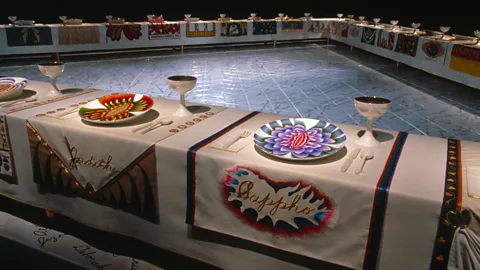 Judy Chicago
Judy Chicago5. Judy Chicago, Dinner Party, 1979
Consisting of 39 place settings commemorating the contribution of women to cultural history (from Sappho to Virginia Woolf), US artist Judy Chicago’s triangularly constructed banquet table has been both acclaimed for its pioneering perspective and derided for its shocking vulgarity. The work is dominated by almost two score hand-painted china plates, many of which are decorated with a blossoming vulva-like butterfly symbol. Believing that the work has “too many vaginas”, contemporary British artist Cornelia Parker scorned the installation in The Guardian as “all about Judy Chicago's ego rather than the poor women she's supposed to be elevating”. “We're all reduced to vaginas, which is a bit depressing.”
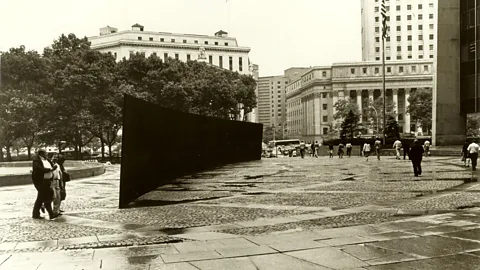 Alamy
Alamy6. Richard Serra, Tilted Arc, 1981
More than one iconic wall fell in 1989. In the dead of night on 15 March, eight months before sledgehammers began pounding the Berlin Wall, a team of construction workers descended on Federal Plaza in New York City to slice into pieces a 120ft (36m)-long, 12ft (3.6m)-high, controversial barricade of steel that had been erected eight years earlier. Contending that the work, a ground-breaking sculpture by the US artist Richard Serra, provided shelter for terrorists, vermin and vandals alike, a jury concluded the minimalist sculpture should be removed and hauled off to a warehouse.
 Christo and Jeanne-Claude
Christo and Jeanne-Claude7. Christo and Jeanne-Claude, Surrounded Islands, 1983
Not everyone who looked upon the 11 islands in Miami’s Biscayne Bay, skirted surreally in pink polypropylene fabric for two weeks in May 1983 by the artists Christo and Jeanne-Claude, was seduced by its fairytale magic. Environmentalists protested the work’s installation, worried about the long-term effect of the 6.5m sq ft (603,870 sq m) of synthetic plastic stretched across the habitats of manatees and nesting ospreys. The dialogue that constructing the work generated, which forced local officials and residents to discuss the fragility of the environment in which they lived, was among the artists’ aims.
 Alamy
Alamy8. Tracey Emin, My Bed, 1998
Though the bed, as an archetypal object, has served as an indispensable prop in some of the greatest works of Western art – from Titian’s Venus of Urbino to Van Gogh’s Bedroom in Arles, from Goya’s alternately nude and dressed Majas to Henry Fuseli’s devilish The Nightmare – public outrage at the installation by British artist Tracey Emin of her dishevelled My Bed for the 1998 Turner Prize Exhibition was intense and sustained. The site of a depressive episode in the artist’s life, surrounded by the material debris of a tousled psyche, the rumpled bed quickly became Exhibit A for those contending that contemporary art had lost its way. Defenders of the work were surprised that, more than 80 years after Marcel Duchamp’s urinal, a messy bed could spark such outrage and wondered whether the real objection was that a woman should so brazenly set up residency in a man’s museum.
 David Černý
David Černý9. David Černý, Shark, 2005
Riffing off of British artist Damien Hirst’s audacious installation The Physical Impossibility of Death in the Mind of Someone Living (1991), which featured a howling shark suspended in a formaldehyde solution, Czech artist David Černý’s arresting vitrine dared to float before visitors a hogtied sculpture of the deposed Iraqi dictator Saddam Hussein. For some, the work came too close to casting Hussein in the role of victim. For others, the piece was gratuitously graphic. The scheduled exhibition of the controversial work at a museum in Middelkerke, Belgium, in early 2006 was ultimately cancelled, by decree of the town’s mayor Michel Landuyt, out of fear “that certain population groups would find the work too provocative".
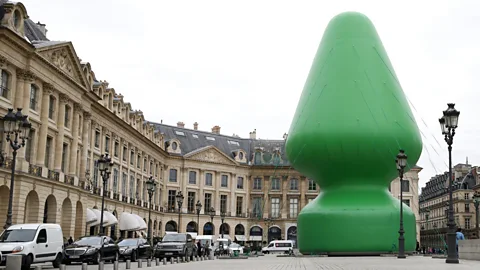 AFP
AFP10. Paul McCarthy, Tree, 2014
Occasionally, the urge to censor a controversial work has been acted upon by offended observers rather than cautious curators. Such was the case in October 2014, when US artist Paul McCarthy’s huge inflatable sculpture Tree, erected as a Christmas display on the Place Vendôme in Paris, was fatally toppled by vandals and subsequently deflated. Once the sculpture’s close resemblance to the shape of a sex prop was pointed out by commentators – a kinship that was, then, impossible to un-see – there was no protecting the colossal work from assault. Nor did the artist himself escape unscathed. An outraged attendee at the sculpture’s installation confronted McCarthy and slapped his face three times before zipping off, like a popped balloon, into the crowd.
If you would like to comment on this story or anything else you have seen on BBC Culture, head over to our Facebook page or message us on Twitter.
And if you liked this story, sign up for the weekly bbc.com features newsletter, called “If You Only Read 6 Things This Week”. A handpicked selection of stories from BBC Future, Earth, Culture, Capital and Travel, delivered to your inbox every Friday.
